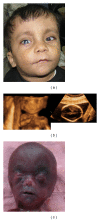Prenatal diagnosis of fetal peters' plus syndrome: a case report
- PMID: 23984120
- PMCID: PMC3745879
- DOI: 10.1155/2013/364529
Prenatal diagnosis of fetal peters' plus syndrome: a case report
Abstract
Peters' plus syndrome is a rare but clinically recognizable autosomal recessive ocular genetic syndrome. Diagnosis during the fetal life is challenging due to the presence of nonspecific findings such as ventriculomegaly in the growth-retarded fetuses. We report the first case of fetal Peters' plus syndrome from India, where fetal ultrasound and the family history were helpful in providing a clue to the diagnosis that was confirmed later on by the DNA analysis.
Figures


References
-
- Hess D, Keusch JJ, Lesnik Oberstein SA, Hennekam RCM, Hofsteenge J. Peters plus syndrome is a new congenital disorder of glycosylation and involves defective O-glycosylation of thrombospondin type 1 repeats. Journal of Biological Chemistry. 2008;283(12):7354–7360. - PubMed
-
- Maillette de Buy Wenniger-Prick LJJM, Hennekam RCM. The Peters’ plus syndrome: a review. Annales de Genetique. 2002;45(2):97–103. - PubMed
-
- Schoner K, Kohlhase J, Müller AM, et al. Hydrocephalus, agenesis of the corpus callosum, and cleft lip/palate represent frequent associations in fetuses with Peters' plus syndrome and B3GALTL mutations. Fetal PPS phenotypes, expanded by Dandy Walker cyst and encephalocele. Prenatal Diagnosis. 2013;33(1):75–80. - PubMed
LinkOut - more resources
Full Text Sources
Other Literature Sources

